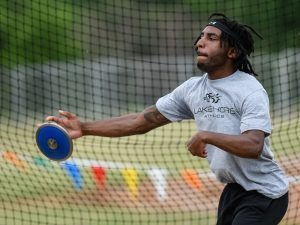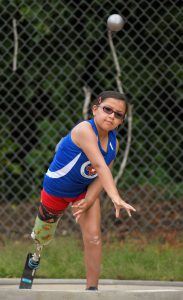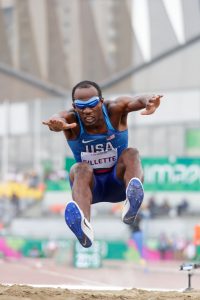Track and Field
LEAVING IT ALL OUT ON THE FIELD: Exploring the Field Events in Track & Field
Track and Field is the largest Olympic and Paralympic sport in terms of the number of athletes and number of classifications and categories. In addition to the races that take place on the track, there are a number of competitions that take place on the field inside the track. In particular, there are throwing and jumping events. On the field at each of these events, you get a chance to test your own ability.
For starters, there are a number of throwing events in field competition. Erica Wheeler, a 1996 U.S. Olympian in javelin who has been coaching Paralympic athletes in the same event for the past 10 years, suggests that throwing isn’t as abstract as we think it is. “Growing up, we all threw rocks, balls, Frisbees, and other items,” said Wheeler. So the general concept and throwing motion is relatively the same.
There are three different throwing disciplines in field competition: javelin, shot put, and discus. The goal in each of these events is to throw, hurl or put an object as far as possible. All three sports can be done from an ambulatory or seated position. Let’s take a look at each discipline:
ADAPTIVE JAVELIN
 A javelin is a long, linear spear-like instrument, six to seven feet in length, that you throw from a designated throwing area. “It is lighter than you think,” Wheeler said. “Since it is the lightest, it is the most aerodynamic and typically goes the furthest.”
A javelin is a long, linear spear-like instrument, six to seven feet in length, that you throw from a designated throwing area. “It is lighter than you think,” Wheeler said. “Since it is the lightest, it is the most aerodynamic and typically goes the furthest.”
For ambulatory athletes, a runway provides the competitor with a track to run on before launching the javelin as far as you can. Seated athletes throw from a chair in a stationary position. The javelin is held in one hand near its center and must be thrown over the shoulder. The tip of the javelin must be the first to land in order to count (can’t land flat or tail first). It must also land within the defined landing sector, which gets wider the further out you get.
Each throw is then measured from the back part of the toe board.
GETTING STARTED
When you are trying out the sport, Wheeler suggests first getting a sense of the throwing motion. “It doesn’t have to be technically perfect.” When you are getting started, you can use a variety of linear items including a normal stick or broomstick.
For seated athletes, early on you can just use a regular chair or something like a cooler to assist with stability and coordination. “Don’t worry about money or equipment.” Once you start going to a local training program, you can use general program chairs which are adjustable for various athletes. When you get serious about competing, then you might want to invest in a throwing chair that is specific to you.
Although the arm is the delivery method, the process of throwing involves the rest of the body. “For javelin, it is not so much about strength as it is technique,” Wheeler said.
TIME TO COMPETE
At a competition, each athlete gets four minutes to prepare, which includes any warm up throws they may want to take. For seated athletes, the chair is tied down to ensure safety and provide stability. After it is secured, you are then secured to the chair through various straps to prevent you from lifting your hips. Athletes must be in contact with the chair from the back of knee to butt through the entire duration of the throw. You can also have a strap placed at the front of the knees and may be strapped to the footplate on the chair as well so to avoid any movement from the waist down. Ambulatory athletes that use the runway must avoid stepping on top of the toe board. Athletes get up to six throws with the furthest distance being counted.
ADAPTIVE DISCUS
 A discus is a circular object, typically weighing around three pounds, that athletes spin off their fingers. Ambulatory athletes may start out facing away from the throwing field and spin around one and a half times to release the disk in a sidearm fashion. Some standing athletes as well as seated athletes may throw from a stationary position, using the trunk and upper extremity rotation to generate force.
A discus is a circular object, typically weighing around three pounds, that athletes spin off their fingers. Ambulatory athletes may start out facing away from the throwing field and spin around one and a half times to release the disk in a sidearm fashion. Some standing athletes as well as seated athletes may throw from a stationary position, using the trunk and upper extremity rotation to generate force.
The ring, or space in which the throw is generated, has a caged enclosure to prevent errant throws from heading toward spectators or other participants. Three-time Paralympic Gold Medalist Jeremy Campbell calls the ring “an 8-foot (in diameter) concrete circle that he spends a lot of time spinning around in.”
Campbell also states that a “legal throw” must land within the designated and marked landing area. “The discus has to land inside the lines,” he said. “And if your body goes outside the circle during the throw it is a foul.” Each athlete gets up to six throws with the best throw counted.
He also suggests that all athletes focus on the fundamentals of the throw. For ambulatory athletes like Campbell, the wind up is important. “Some athletes go fast in the ring. For me, it is not the speed of the body, but the velocity upon release.”
You will almost want to sling the discus. The rotation of the body in the ring helps create separation and facilitates getting the discus away from body. Apart from the fundamentals, posture and position are critical to a successful throw When you first arrive to a competition, Campbell suggests that athletes get acclimated to the environment. “Each venue feels different. In addition, new rings could be slick.” Weather can also be a factor during competition. “Headwind is fine,” he said. “But tailwind is not good.”
ADAPTIVE SHOT PUT
 The purpose of shot put is to throw, or put, a spherical metal shot (hence the name). Of the three throwing instruments, the shot is the heaviest. In many cases, athletes that compete in this category focus on sheer power and explosion. “This sport is more strength based,” Wheeler said. “The others are more rhythmic.”
The purpose of shot put is to throw, or put, a spherical metal shot (hence the name). Of the three throwing instruments, the shot is the heaviest. In many cases, athletes that compete in this category focus on sheer power and explosion. “This sport is more strength based,” Wheeler said. “The others are more rhythmic.”
The athlete starts in a designated circular throwing area called a ring. The shot is held in one hand against the neck and chin area. The put is executed in a pushing fashion, with the point of release being above the level of the shoulder. Athletes don’t want to get the shot too far from the midline as the shot can’t drop below a certain position during the throw.
Similar to discus, standing athletes may begin by facing away from the throwing field and generate force via a “spin” or “glide” technique. The spin is like the rotation in discus, and the glide is a forceful turn from the rear-facing position where the athlete pushes off the dominant leg. Seated athletes put from a stationary throwing frame. And like all throwing events, the put must land in the marked landing area to count.
ADAPTIVE LONG JUMP
 In addition to the three throwing competitions, there are also three jumping events. These include the long jump, high jump, and triple jump. We will focus our attention on the long jump.
In addition to the three throwing competitions, there are also three jumping events. These include the long jump, high jump, and triple jump. We will focus our attention on the long jump.
Jumping events do center around ambulatory athletes, but classifications do exist for visual impairments and other disabilities. World Champion and four-time Silver Medalist Lex Gillette, who is blind, suggests that a lot of jumpers train like sprinters. “The more speed you bring down the runway, the better,” Gillette said. “Your coach may have you enter sprints to help improve your ability.”
For long jumps, each competition area includes a runway and a sandpit. “Runway lengths may vary from venue to venue,” Gillette said. At the end of the runway, jumpers must launch from the takeoff board without stepping over the edge of it (fault line). Otherwise, that jump is considered a foul and doesn’t count. The sandpit is the spot where athletes land after completing their jump.
When it comes to jumping everyone has their own approach, according to Gillette. “There is a standing approach and walk-in approach, which allows you to explode into your run,” he said. “My approach is approximately 16 steps, or 34 ½ meters.”
You also jump off of the opposite leg. Lex is right handed and jumps from his left leg. “When you jump or leap from ground, it is your dominant leg.”
Distance is measured from the board (or toe mark) to the part of the body in the sand that lands closest to the board. During your jump, you want to keep everything forward. “You want to keep your arms up, come forward, and sweep through. The more you control that follow[1]through, the better.”
For athletes with a visual impairment, two markers are allowed on the track. In addition, you have a coach or guide that can clap or yell to know which direction you’re running or other cues.
In addition to strength training, Gillette does a lot of jump roping. He focuses on strengthening his ankles and toes, box jumps and jump drills, and hitting his runway marks. Stretching, rest, and recovery are also important.
FIND A PROGRAM
Wheeler suggests researching various training programs near you. “Even if one isn’t close to you, reach out to the nearest one because they can still be a resource for you.” Dozens of Move United member organizations offer track and field programs. In addition, Move United offers a series of nearly two dozen sanctioned competitions as well as Move United Junior Nationals as a way for you to compete in these sports.

